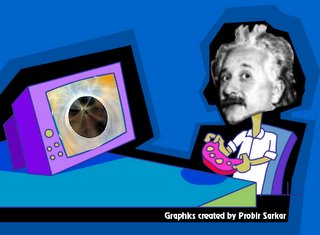The Other Side of Infinity
Video game technology and Einstein's work on relativity may at first seem as unlikely a couple as Oscar and Felix.
 "What if you could take people through a wormhole the way Einstein's equations said it would be?" he said in interview in his office on the Boulder campus. "And what if you could bring art and science together in a way that compromised neither?"
"What if you could take people through a wormhole the way Einstein's equations said it would be?" he said in interview in his office on the Boulder campus. "And what if you could bring art and science together in a way that compromised neither?"That is where black holes come in. Dr. Hamilton's (Andrew J. S. Hamilton, a professor of astrophysics at the University of Colorado) marriage of video game software and relativity, which he has fashioned into a "Black Hole Flight Simulator," is at the heart of a new show at the Denver Museum of Nature and Science that takes viewers on a 23-minute thrill ride to what the program notes call "the other side of infinity."
The show is built on the crunching of numbers that even a black hole might envy: some segments produced by the National Center for Supercomputing Applications at the University of Illinois required 90 hours of supercomputer calculation for each second on screen.
The central goal, Dr. Hamilton said, is both simple and mind-bendingly paradoxical: to visualize what cannot be seen.
Because not even light can escape the gravitational pull of a black hole, the interior of a hole is perhaps the ultimate terra incognita. The absence of light coming out means an absence of all information. Most of what science knows about these objects is thus entirely inferential — from gravitational effects on other objects like nearby stars.
The simulator, to be featured this year in a "Nova" program on PBS about black holes, seeks to lift the veil. Using Einstein's equations and a graphics language called Open GL, developed by Silicon Graphics, Dr. Hamilton told the computer to show how individual vectors of light should behave at the no-man's frontier of the black hole, called the event horizon, and inside the hole itself.
That meant not only creating a visual representation of Einstein's work, but also in a real sense creating from scratch a world that cannot be known. "When I started this, I had no idea what would emerge from the equations," Mr. Hamilton said. Part of the thrill was the exploration. The computer would go where the human mind by itself could not.